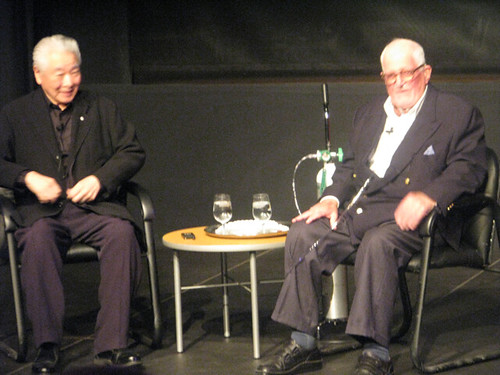You think you know a place, a building. Maybe it’s because you live in it, or work there. Or you’re a regular visitor, perhaps.
Then you get to learn what its designers were thinking. Sometimes, what you learn may be a shock. Other instances, it’s an affirmation.
Last night marked the start of the 2012 edition of Architecture Week in Ottawa, beginning with a shared reminiscence at the National War Museum on Lebreton Flats about its origins. This particular event marked perhaps both for a packed house largely made up of architecture students and other people with like interests.
The people doing the remembering in this instance were the two architects leading the team whose proposal won the national competition to design the place, Alex Rankin and Raymond Moriyama. Both now retired from full-time work, Rankin and Moriyama reunited at the behest of Carleton University to launch also this year’s edition of Carleton’s Forum Lecture Series. Their discussion focused on the design process leading up to the awarding of the contract, as well as specific elements of the War Museum itself.
It lasted roughly two hours, and while much of what came up in the discussion may well be already known in professional circles, it was an eye-opener at times for this member of the audience. Of particular note were the inspiration that Mr. Moriyama took from the design team’s consultation with the public at large in preparation for submitting their proposal to the federal government some twelve years ago. One woman spoke of war as “a descent into Hell” and it stuck with Moriyama, all the way to the construction of the lobby. The theme of regeneration kept coming up as well, perhaps as expected given the additional inspiration provided by the fate of the fields of Passchendaele in the wake of that key battle of World War One.
Of those who survived the battle there, it would be forever thought of as Hell on Earth. In the decades since, the former war zone has almost returned completely to forest land. The regeneration there echoes in the design of the roof of the Museum, seeded with grasses and allowed to grow as wild as possible within the context of the facility. One consequence that they didn’t anticipate and found in Rankin’s words “very good” in the years since completion has been the usage of the roof lawn for the purposes of JazzFest and BluesFest.
Again…you think you know a place. Sometimes it’s because you live or work there.
Or perhaps it’s because you designed it.
And then reality surprises you, either way.
As for the rest of Architecture Week, this year’s edition focuses on the theme of lighting, and how it works ideally as part of the overall design of a building. The lion’s share of this year’s activities will be hosted by the St. Brigid Centre for the Arts and Humanities on the corner of St. Patrick and Cumberland. Guest speakers are set to include the likes of Louise Lalande, Paul Mercier and Phil Gabriel among others. Other activities include walking tours of the Ottawa Convention Centre and St. Brigid’s, an architectural-themed bike tour, pub crawl and a kids’ clinic.
Details and a fuller schedule are available at the Architecture Week 2012 website.


